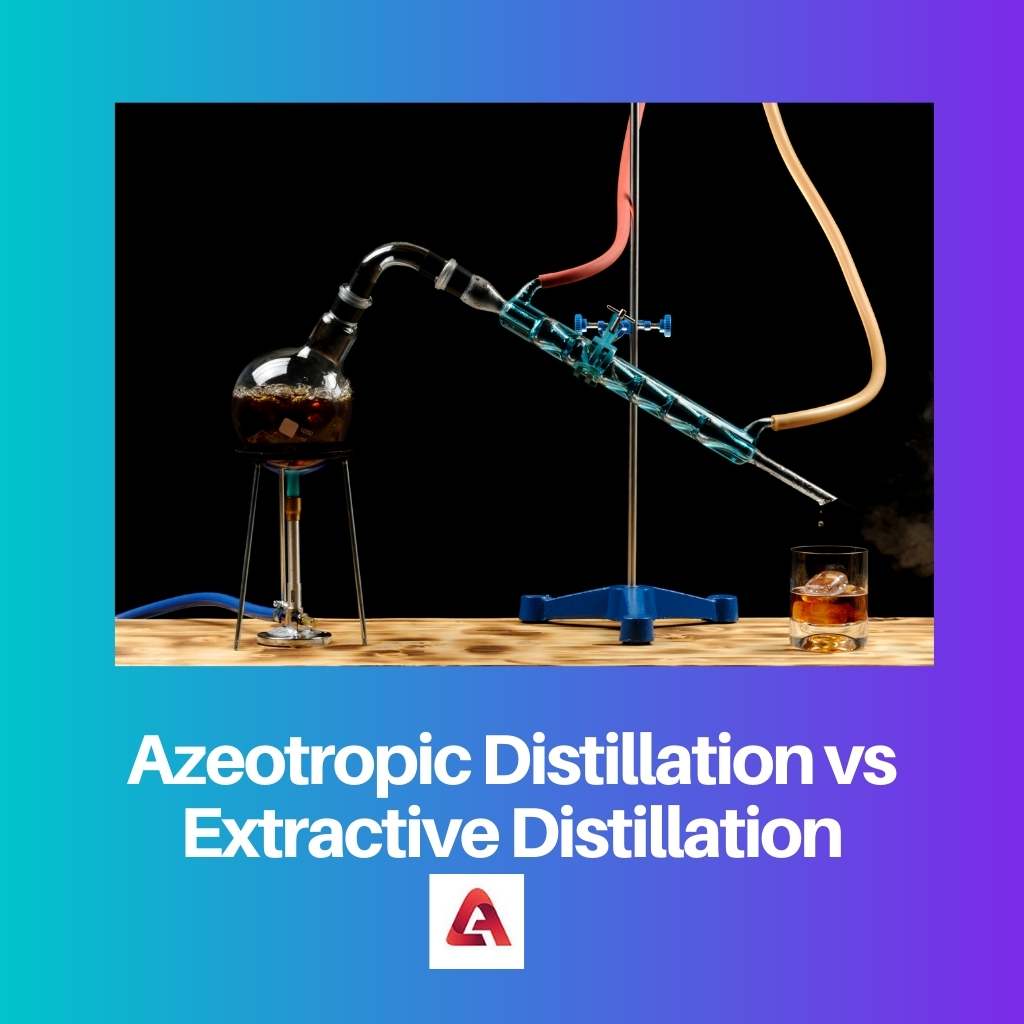Distillation is defined as the process of separating the components from their liquid mixture using various techniques.
While there are many methods of distillation, including conventional, fractional, steam, etc., azeotropic distillation and extractive distillation are two methods that are confused with each other.
Key Takeaways
- Azeotropic distillation uses an entertainer to break azeotropic mixtures into two separate components.
- Extractive distillation involves a solvent that selectively dissolves one component, easing its separation from the other.
- Azeotropic distillation is ideal for separating components with similar boiling points, while extractive distillation is used for mixtures with a wide range of boiling points.
Azeotropic Distillation vs Extractive Distillation
The difference between azeotropic distillation and extractive distillation is in the process that each one follows to separate the components of a mixture. In azeotropic distillation, an azeotrope needs to be formed in the process, whereas extractive distillation restricts the formation of azeotropes.

Azeotropic Distillation is defined as a technique of separating the components of an azeotropic mixture with the help of a specialized distillation process.
In an azeotropic mixture, more than one type of liquid cannot be separated using simple distillation.
Extractive Distillation is defined as a distillation process of separating two components from a mixture with the addition of a high-boiling solvent.
The solvent’s boiling point should be much higher than the components of the mixture so that new azeotropes cannot be formed.
Comparison Table
| Parameters of Comparison | Azeotropic Distillation | Extractive Distillation |
|---|---|---|
| Azeotrope | Depends on the formation of the azeotrope. | Strictly resists the formation of the azeotrope. |
| Application | It is used while experimenting in labs. | It is used for manufacturing and production. |
| Product | It is obtained at the column’s top. | It is obtained at the column’s bottom. |
| Process | It is a complicated process. | It is a simpler process. |
| Time | It is more time-consuming. | It takes less time. |
What is Azeotropic Distillation?
Azeotropic Distillation is defined as a technique of separating the components of an azeotropic mixture with the help of a specialized distillation process.
In an azeotropic mixture, more than one type of liquid cannot be separated using simple distillation. This is because boiling liquids in the azeotropic mixture contain the same proportions.
In distillation, the components of a mixture can be separated due to differences in their volatilities, whereas, in an azeotropic mixture, the volatilities of components are also similar.
To overcome this hurdle, an additional volatile component, known as an entertainer, is added to the mixture. As a result, the volatility of one of the liquids noticeably changes, thus separating it from the other.
Azeotropic mixtures are mainly of two types minimum boiling azeotropes, which boil at relatively low temperatures, and maximum boiling azeotropes, which boil at relatively high temperatures.
Most commonly known azeotropic mixtures are composed of water and ethanol substances. Additional solvents, such as benzene, hexane, cyclohexane, etc., are required to separate the two.
In most cases, benzene is used for azeotropic distillation. The addition of an entertainer changes the molecular interactions to eliminate the azeotrope, and hence, it alters the relative volatility of the mixture.
What is Extractive Distillation?
Extractive Distillation is defined as a distillation process of separating two components from a mixture with the addition of a high-boiling solvent.
The solvent’s boiling point should be much higher than the components of the mixture so that new azeotropes cannot be formed. It makes sure that the solvent is not vaporized at the boiling point of components.
Extractive distillation is most commonly used to separate toluene from iso-octane. Conventional distillation makes separating these two difficult as their boiling points are nearly similar.
In such a case, phenol, which has a much higher boiling point than the components, is added to the mixture.
This results in the production of a phenol-toluene mixture that leaves at the bottom, while iso-octane is recovered as an overhead product.
The phenol-toluene mixture is then separated into a different columns using a simple distillation process.
Phenol is the most used solvent in this process as it has a higher boiling point and prevents foaming.
Unlike azeotropic distillation, this process strictly restricts the formation of new azeotropes and separates the components solely with vaporization.
Since azeotropes are absent in this process, this process is much simpler than azeotropic distillation.
Extractive distillation is highly practical and more widely used than other processes.
Main Differences Between Azeotropic and Extractive Distillation
- Azeotrope formation occurs in azeotropic distillation, whereas it does not occur in extractive distillation.
- In azeotropic distillation, the solvent doesn’t need a high-boiling point; in extractive distillation, the solvent needs a very high-boiling point.
- Azeotropic distillation is a more complicated process when compared to extractive distillation, which is simple.
- Azeotropic distillation separates the component from the vapour phase, whereas extractive distillation separates the component from a matrix of substances.
- The product obtained from azeotropic distillation is from the top of the column, whereas the product obtained from extractive distillation is from the bottom of the column.
- https://pubs.acs.org/doi/pdf/10.1021/ie50418a002
- https://www.tandfonline.com/doi/abs/10.1081/spm-120026627

An entertaining and enlightening article. Bravo to the author!
Very enlightening, indeed. The article is a must-read for anyone interested in chemical processes and distillation.
I found this article very informative, particularly as I’m working in a related field.
It’s amazing how the addition of an entertainer in azeotropic distillation can alter the volatility of liquids. Very thoroughly explained!
The difference between azeotropic distillation and extractive distillation is very well explained. Good article!
I agree, this article is great for anyone who has questions about the topic
Although the topic is quite complicated, the article makes it easy for anyone to understand. Great job!
An interesting read, very clear and detailed explanation about the topic